Business Law Report: English Legal System and Legal Solutions Analysis
VerifiedAdded on 2020/10/04
|13
|4095
|387
Report
AI Summary
This report provides a detailed overview of the English legal system, focusing on its structure and various sources of law, including criminal, civil, and equity law. It examines the role of the government in making legislations, the application of common and statutory law, and the processes involved in passing bills. The report also addresses employer's legal obligations, referencing relevant acts like the Employment Rights Act, NMW Act, Working Time Regulation Act, and Pension Act. Furthermore, it analyzes business problems, offering legal solutions and comparing alternative recommendations based on case scenarios. The report also explores the structure of the English legal system, including the Magistrate's court, County court, and Crown court. Overall, this report offers a comprehensive analysis of business law and its practical applications within the UK legal framework.

BUSINESS LAW
Paraphrase This Document
Need a fresh take? Get an instant paraphrase of this document with our AI Paraphraser
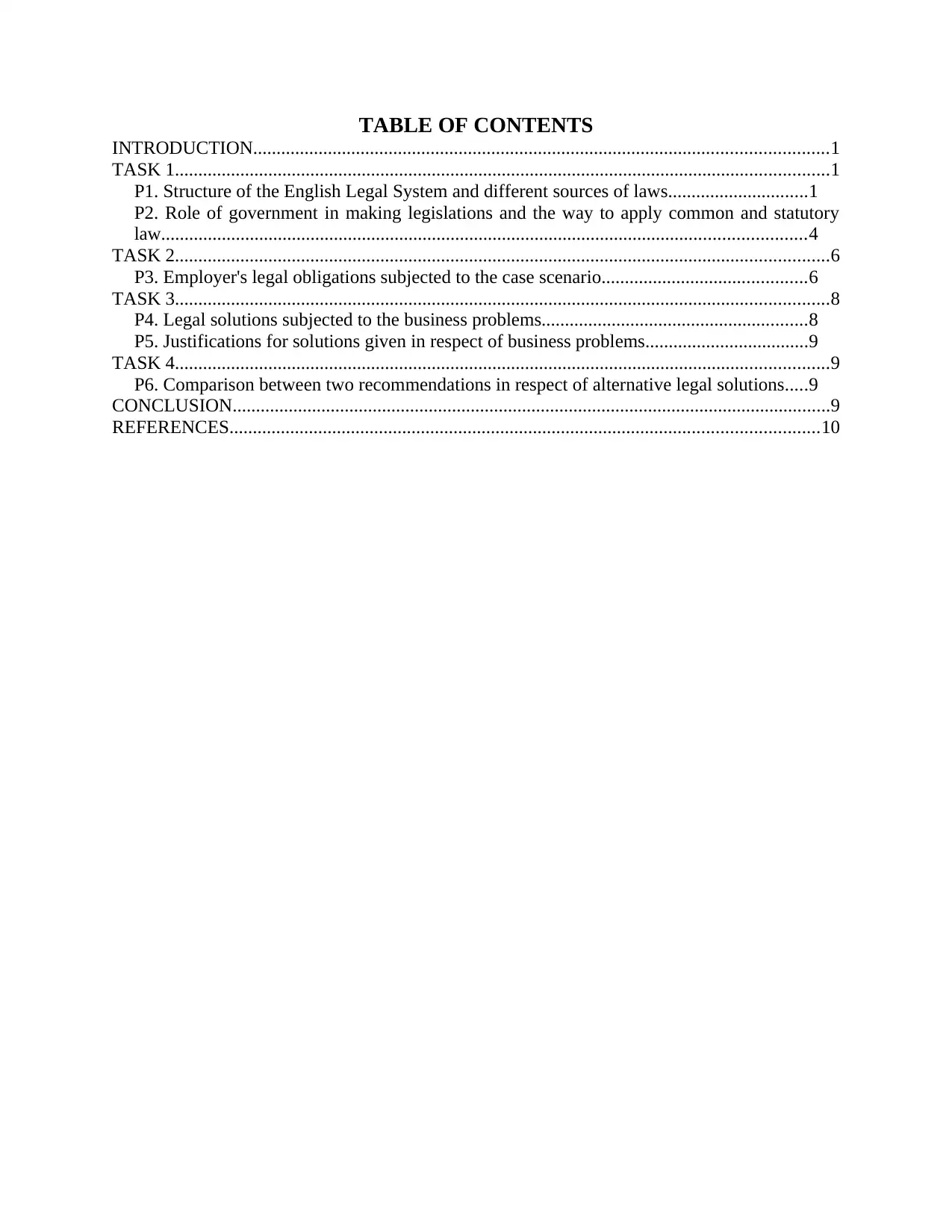
TABLE OF CONTENTS
INTRODUCTION...........................................................................................................................1
TASK 1............................................................................................................................................1
P1. Structure of the English Legal System and different sources of laws..............................1
P2. Role of government in making legislations and the way to apply common and statutory
law..........................................................................................................................................4
TASK 2............................................................................................................................................6
P3. Employer's legal obligations subjected to the case scenario............................................6
TASK 3............................................................................................................................................8
P4. Legal solutions subjected to the business problems.........................................................8
P5. Justifications for solutions given in respect of business problems...................................9
TASK 4............................................................................................................................................9
P6. Comparison between two recommendations in respect of alternative legal solutions.....9
CONCLUSION................................................................................................................................9
REFERENCES..............................................................................................................................10
INTRODUCTION...........................................................................................................................1
TASK 1............................................................................................................................................1
P1. Structure of the English Legal System and different sources of laws..............................1
P2. Role of government in making legislations and the way to apply common and statutory
law..........................................................................................................................................4
TASK 2............................................................................................................................................6
P3. Employer's legal obligations subjected to the case scenario............................................6
TASK 3............................................................................................................................................8
P4. Legal solutions subjected to the business problems.........................................................8
P5. Justifications for solutions given in respect of business problems...................................9
TASK 4............................................................................................................................................9
P6. Comparison between two recommendations in respect of alternative legal solutions.....9
CONCLUSION................................................................................................................................9
REFERENCES..............................................................................................................................10
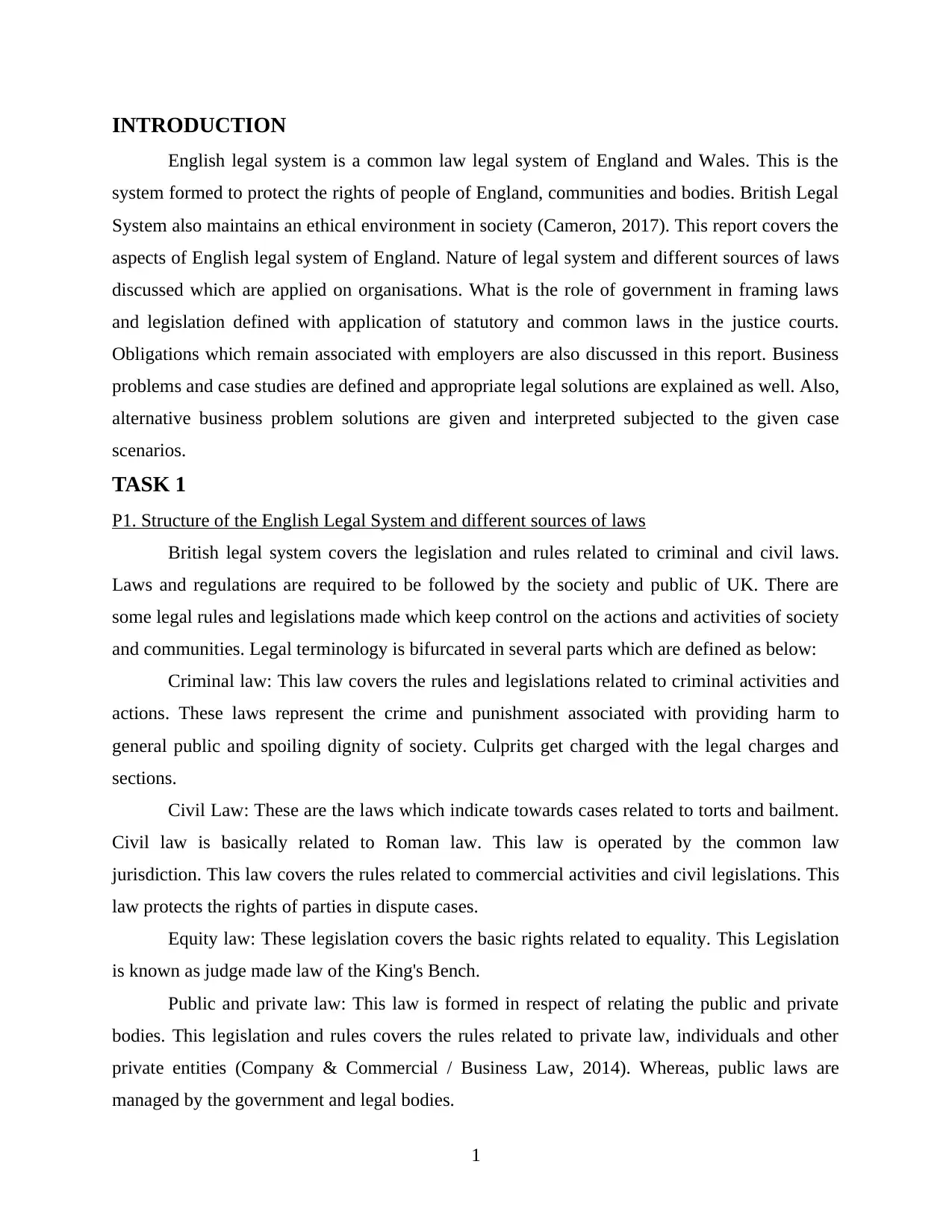
INTRODUCTION
English legal system is a common law legal system of England and Wales. This is the
system formed to protect the rights of people of England, communities and bodies. British Legal
System also maintains an ethical environment in society (Cameron, 2017). This report covers the
aspects of English legal system of England. Nature of legal system and different sources of laws
discussed which are applied on organisations. What is the role of government in framing laws
and legislation defined with application of statutory and common laws in the justice courts.
Obligations which remain associated with employers are also discussed in this report. Business
problems and case studies are defined and appropriate legal solutions are explained as well. Also,
alternative business problem solutions are given and interpreted subjected to the given case
scenarios.
TASK 1
P1. Structure of the English Legal System and different sources of laws
British legal system covers the legislation and rules related to criminal and civil laws.
Laws and regulations are required to be followed by the society and public of UK. There are
some legal rules and legislations made which keep control on the actions and activities of society
and communities. Legal terminology is bifurcated in several parts which are defined as below:
Criminal law: This law covers the rules and legislations related to criminal activities and
actions. These laws represent the crime and punishment associated with providing harm to
general public and spoiling dignity of society. Culprits get charged with the legal charges and
sections.
Civil Law: These are the laws which indicate towards cases related to torts and bailment.
Civil law is basically related to Roman law. This law is operated by the common law
jurisdiction. This law covers the rules related to commercial activities and civil legislations. This
law protects the rights of parties in dispute cases.
Equity law: These legislation covers the basic rights related to equality. This Legislation
is known as judge made law of the King's Bench.
Public and private law: This law is formed in respect of relating the public and private
bodies. This legislation and rules covers the rules related to private law, individuals and other
private entities (Company & Commercial / Business Law, 2014). Whereas, public laws are
managed by the government and legal bodies.
1
English legal system is a common law legal system of England and Wales. This is the
system formed to protect the rights of people of England, communities and bodies. British Legal
System also maintains an ethical environment in society (Cameron, 2017). This report covers the
aspects of English legal system of England. Nature of legal system and different sources of laws
discussed which are applied on organisations. What is the role of government in framing laws
and legislation defined with application of statutory and common laws in the justice courts.
Obligations which remain associated with employers are also discussed in this report. Business
problems and case studies are defined and appropriate legal solutions are explained as well. Also,
alternative business problem solutions are given and interpreted subjected to the given case
scenarios.
TASK 1
P1. Structure of the English Legal System and different sources of laws
British legal system covers the legislation and rules related to criminal and civil laws.
Laws and regulations are required to be followed by the society and public of UK. There are
some legal rules and legislations made which keep control on the actions and activities of society
and communities. Legal terminology is bifurcated in several parts which are defined as below:
Criminal law: This law covers the rules and legislations related to criminal activities and
actions. These laws represent the crime and punishment associated with providing harm to
general public and spoiling dignity of society. Culprits get charged with the legal charges and
sections.
Civil Law: These are the laws which indicate towards cases related to torts and bailment.
Civil law is basically related to Roman law. This law is operated by the common law
jurisdiction. This law covers the rules related to commercial activities and civil legislations. This
law protects the rights of parties in dispute cases.
Equity law: These legislation covers the basic rights related to equality. This Legislation
is known as judge made law of the King's Bench.
Public and private law: This law is formed in respect of relating the public and private
bodies. This legislation and rules covers the rules related to private law, individuals and other
private entities (Company & Commercial / Business Law, 2014). Whereas, public laws are
managed by the government and legal bodies.
1
⊘ This is a preview!⊘
Do you want full access?
Subscribe today to unlock all pages.

Trusted by 1+ million students worldwide
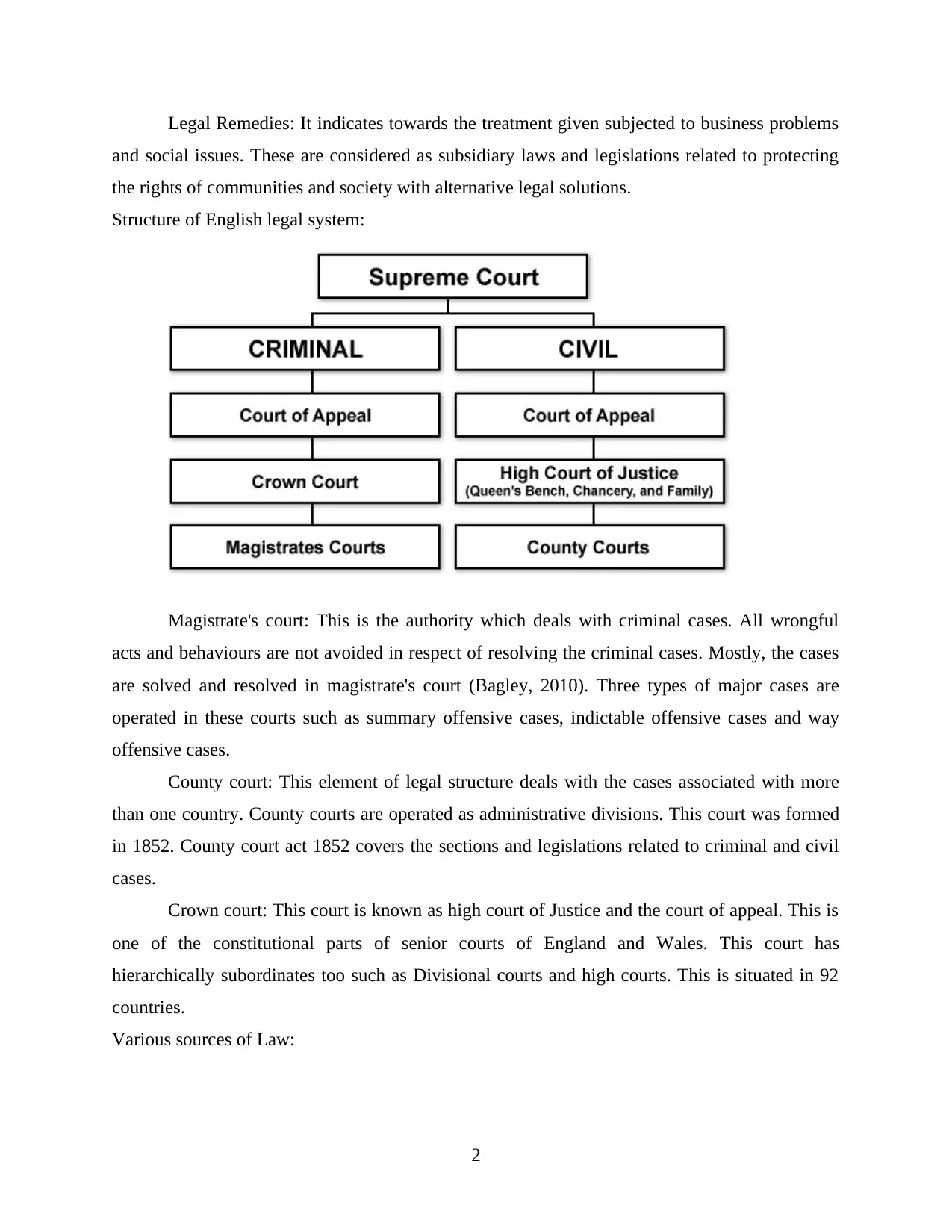
Legal Remedies: It indicates towards the treatment given subjected to business problems
and social issues. These are considered as subsidiary laws and legislations related to protecting
the rights of communities and society with alternative legal solutions.
Structure of English legal system:
Magistrate's court: This is the authority which deals with criminal cases. All wrongful
acts and behaviours are not avoided in respect of resolving the criminal cases. Mostly, the cases
are solved and resolved in magistrate's court (Bagley, 2010). Three types of major cases are
operated in these courts such as summary offensive cases, indictable offensive cases and way
offensive cases.
County court: This element of legal structure deals with the cases associated with more
than one country. County courts are operated as administrative divisions. This court was formed
in 1852. County court act 1852 covers the sections and legislations related to criminal and civil
cases.
Crown court: This court is known as high court of Justice and the court of appeal. This is
one of the constitutional parts of senior courts of England and Wales. This court has
hierarchically subordinates too such as Divisional courts and high courts. This is situated in 92
countries.
Various sources of Law:
2
and social issues. These are considered as subsidiary laws and legislations related to protecting
the rights of communities and society with alternative legal solutions.
Structure of English legal system:
Magistrate's court: This is the authority which deals with criminal cases. All wrongful
acts and behaviours are not avoided in respect of resolving the criminal cases. Mostly, the cases
are solved and resolved in magistrate's court (Bagley, 2010). Three types of major cases are
operated in these courts such as summary offensive cases, indictable offensive cases and way
offensive cases.
County court: This element of legal structure deals with the cases associated with more
than one country. County courts are operated as administrative divisions. This court was formed
in 1852. County court act 1852 covers the sections and legislations related to criminal and civil
cases.
Crown court: This court is known as high court of Justice and the court of appeal. This is
one of the constitutional parts of senior courts of England and Wales. This court has
hierarchically subordinates too such as Divisional courts and high courts. This is situated in 92
countries.
Various sources of Law:
2
Paraphrase This Document
Need a fresh take? Get an instant paraphrase of this document with our AI Paraphraser
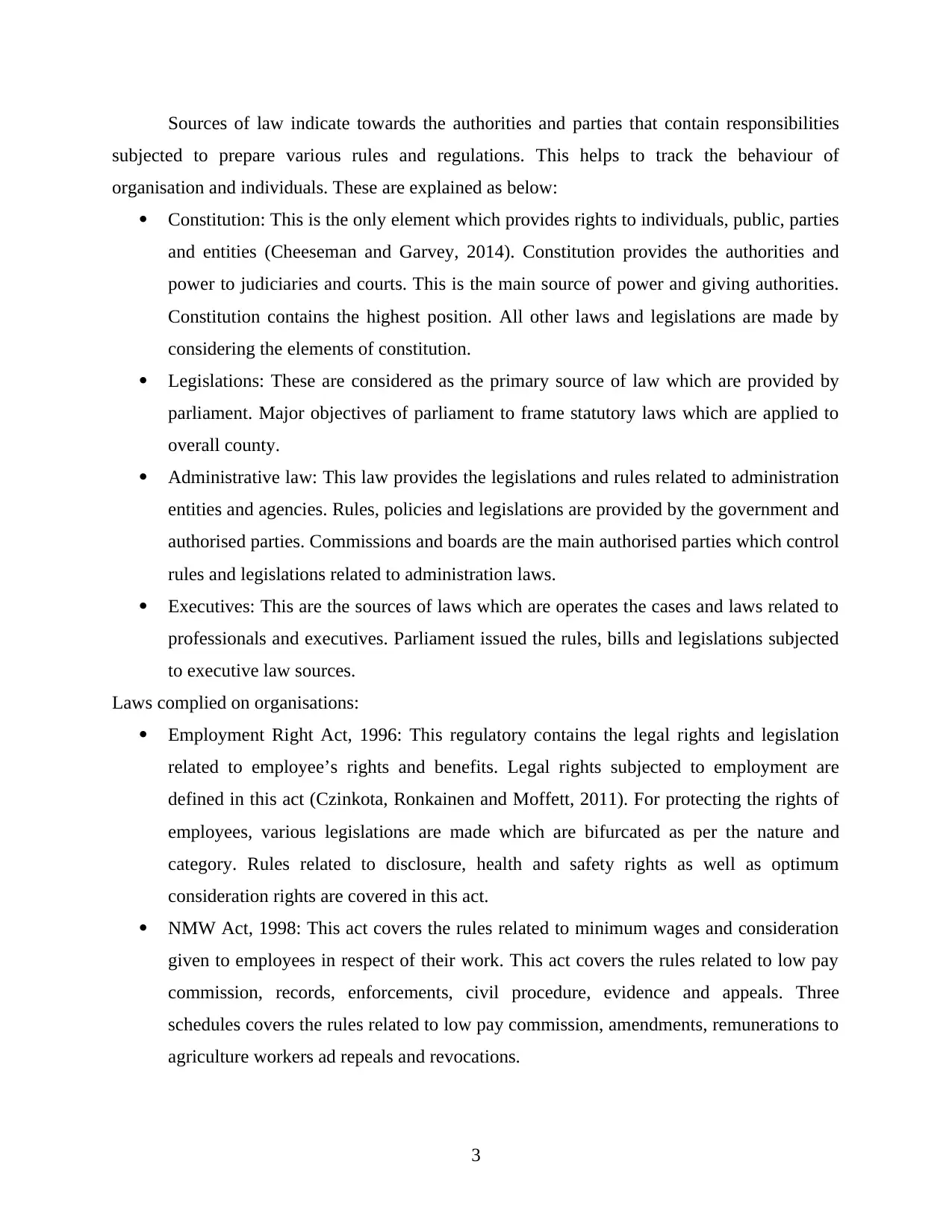
Sources of law indicate towards the authorities and parties that contain responsibilities
subjected to prepare various rules and regulations. This helps to track the behaviour of
organisation and individuals. These are explained as below:
Constitution: This is the only element which provides rights to individuals, public, parties
and entities (Cheeseman and Garvey, 2014). Constitution provides the authorities and
power to judiciaries and courts. This is the main source of power and giving authorities.
Constitution contains the highest position. All other laws and legislations are made by
considering the elements of constitution.
Legislations: These are considered as the primary source of law which are provided by
parliament. Major objectives of parliament to frame statutory laws which are applied to
overall county.
Administrative law: This law provides the legislations and rules related to administration
entities and agencies. Rules, policies and legislations are provided by the government and
authorised parties. Commissions and boards are the main authorised parties which control
rules and legislations related to administration laws.
Executives: This are the sources of laws which are operates the cases and laws related to
professionals and executives. Parliament issued the rules, bills and legislations subjected
to executive law sources.
Laws complied on organisations:
Employment Right Act, 1996: This regulatory contains the legal rights and legislation
related to employee’s rights and benefits. Legal rights subjected to employment are
defined in this act (Czinkota, Ronkainen and Moffett, 2011). For protecting the rights of
employees, various legislations are made which are bifurcated as per the nature and
category. Rules related to disclosure, health and safety rights as well as optimum
consideration rights are covered in this act.
NMW Act, 1998: This act covers the rules related to minimum wages and consideration
given to employees in respect of their work. This act covers the rules related to low pay
commission, records, enforcements, civil procedure, evidence and appeals. Three
schedules covers the rules related to low pay commission, amendments, remunerations to
agriculture workers ad repeals and revocations.
3
subjected to prepare various rules and regulations. This helps to track the behaviour of
organisation and individuals. These are explained as below:
Constitution: This is the only element which provides rights to individuals, public, parties
and entities (Cheeseman and Garvey, 2014). Constitution provides the authorities and
power to judiciaries and courts. This is the main source of power and giving authorities.
Constitution contains the highest position. All other laws and legislations are made by
considering the elements of constitution.
Legislations: These are considered as the primary source of law which are provided by
parliament. Major objectives of parliament to frame statutory laws which are applied to
overall county.
Administrative law: This law provides the legislations and rules related to administration
entities and agencies. Rules, policies and legislations are provided by the government and
authorised parties. Commissions and boards are the main authorised parties which control
rules and legislations related to administration laws.
Executives: This are the sources of laws which are operates the cases and laws related to
professionals and executives. Parliament issued the rules, bills and legislations subjected
to executive law sources.
Laws complied on organisations:
Employment Right Act, 1996: This regulatory contains the legal rights and legislation
related to employee’s rights and benefits. Legal rights subjected to employment are
defined in this act (Czinkota, Ronkainen and Moffett, 2011). For protecting the rights of
employees, various legislations are made which are bifurcated as per the nature and
category. Rules related to disclosure, health and safety rights as well as optimum
consideration rights are covered in this act.
NMW Act, 1998: This act covers the rules related to minimum wages and consideration
given to employees in respect of their work. This act covers the rules related to low pay
commission, records, enforcements, civil procedure, evidence and appeals. Three
schedules covers the rules related to low pay commission, amendments, remunerations to
agriculture workers ad repeals and revocations.
3

Working time regulation Act, 1998: This act covers the rules related to rights and
obligations concerning working time, exceptions and special clauses of working. There
are two schedules made which cover the rules related to workforce agreements and
workers employed in agriculture.
Pension Act, 2008: Pension indicates towards the regular payment to the employees after
completing his or her service period within the organisation (Dickerson, 2011). There are
various rules and legislations defined in the pension act. This act defines the duties of
employees in respect of providing the employment satisfaction and services at workplace.
Relations related to workers without qualifying earnings and supplementary provisions
subject to duties.
P2. Role of government in making legislations and the way to apply common and statutory law
Government plays vital role in making the rules and legislation subject to parliament
authorities. It is the only governing party which provides the rules and legislation in respect of
making new articles and policies (Grundfest, 2010). There is a systematic procedure followed by
the parliament subject to framing the bills, policies and standards. There is an agenda remain
associated with passing the rules and regulation and bills. A bill passes through various steps
such which are defined below:
Issue come forth on schedule of government: this is the first step to introducing the bills
in front of political parties. Political factors play a vital role in formulating new policies and
plans. The political party gives valuable contribution in framing and formulating government
rules. Issues are presented to create a base and theorize the subject.
Solutions regarding specific issues: this is the second phase which is related to next step
after discussing the issue associated with the bills and laws. As the issue get determined, need of
experts occurs to sort out the issues and finding optimum solution regarding issues.
Discussion with fascinated people: it is an essential process helps to consolidate the
relevant information and data reading problems and issues. This step is called as discussion
process in which interested people are asked to participate in solving the issues with relevant
suggestions and solutions (Kinicki and Kreitner, 2012). Aim and objective of this process is to
find out best option by consulting the issue at overall perspective. This process is divided in two
separate parts:
4
obligations concerning working time, exceptions and special clauses of working. There
are two schedules made which cover the rules related to workforce agreements and
workers employed in agriculture.
Pension Act, 2008: Pension indicates towards the regular payment to the employees after
completing his or her service period within the organisation (Dickerson, 2011). There are
various rules and legislations defined in the pension act. This act defines the duties of
employees in respect of providing the employment satisfaction and services at workplace.
Relations related to workers without qualifying earnings and supplementary provisions
subject to duties.
P2. Role of government in making legislations and the way to apply common and statutory law
Government plays vital role in making the rules and legislation subject to parliament
authorities. It is the only governing party which provides the rules and legislation in respect of
making new articles and policies (Grundfest, 2010). There is a systematic procedure followed by
the parliament subject to framing the bills, policies and standards. There is an agenda remain
associated with passing the rules and regulation and bills. A bill passes through various steps
such which are defined below:
Issue come forth on schedule of government: this is the first step to introducing the bills
in front of political parties. Political factors play a vital role in formulating new policies and
plans. The political party gives valuable contribution in framing and formulating government
rules. Issues are presented to create a base and theorize the subject.
Solutions regarding specific issues: this is the second phase which is related to next step
after discussing the issue associated with the bills and laws. As the issue get determined, need of
experts occurs to sort out the issues and finding optimum solution regarding issues.
Discussion with fascinated people: it is an essential process helps to consolidate the
relevant information and data reading problems and issues. This step is called as discussion
process in which interested people are asked to participate in solving the issues with relevant
suggestions and solutions (Kinicki and Kreitner, 2012). Aim and objective of this process is to
find out best option by consulting the issue at overall perspective. This process is divided in two
separate parts:
4
⊘ This is a preview!⊘
Do you want full access?
Subscribe today to unlock all pages.

Trusted by 1+ million students worldwide
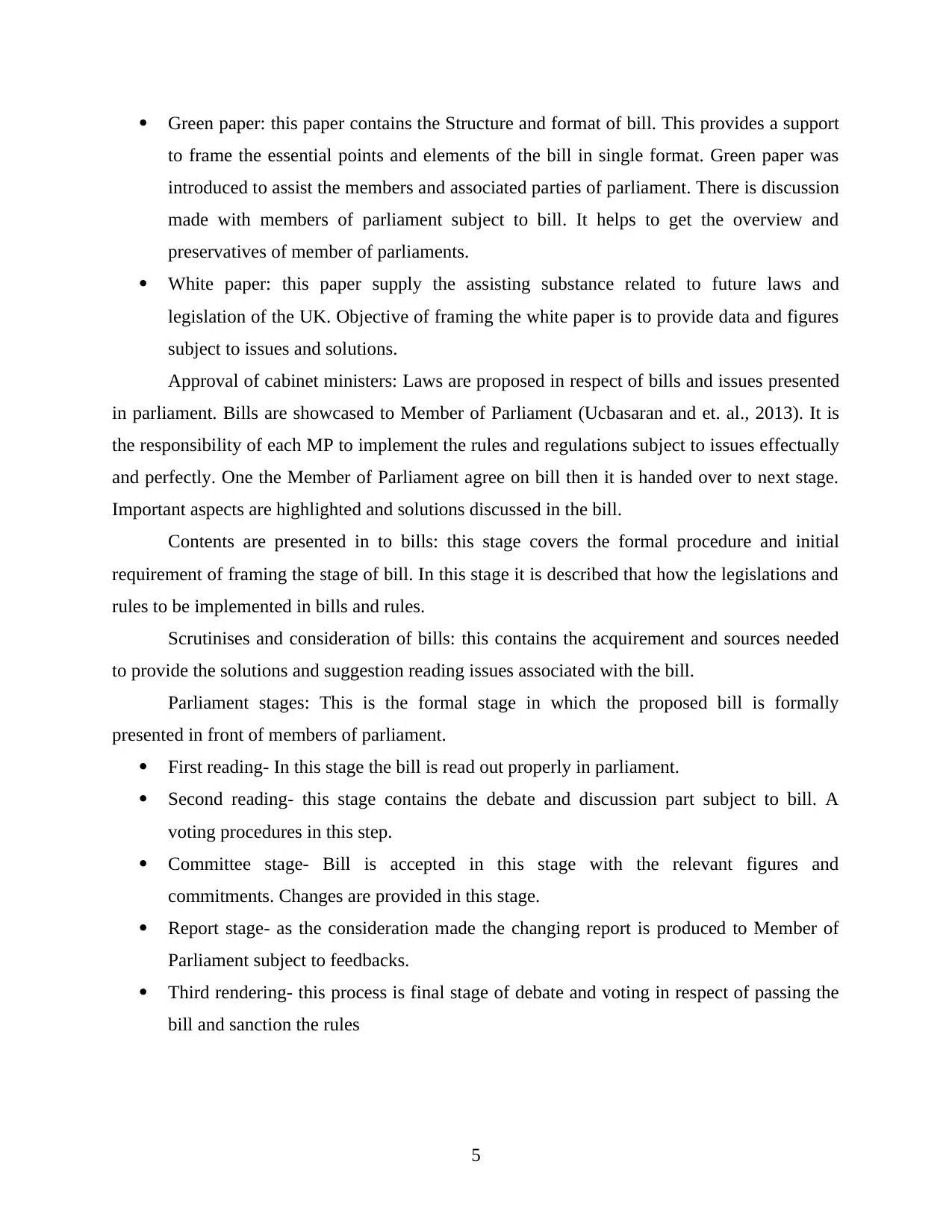
Green paper: this paper contains the Structure and format of bill. This provides a support
to frame the essential points and elements of the bill in single format. Green paper was
introduced to assist the members and associated parties of parliament. There is discussion
made with members of parliament subject to bill. It helps to get the overview and
preservatives of member of parliaments.
White paper: this paper supply the assisting substance related to future laws and
legislation of the UK. Objective of framing the white paper is to provide data and figures
subject to issues and solutions.
Approval of cabinet ministers: Laws are proposed in respect of bills and issues presented
in parliament. Bills are showcased to Member of Parliament (Ucbasaran and et. al., 2013). It is
the responsibility of each MP to implement the rules and regulations subject to issues effectually
and perfectly. One the Member of Parliament agree on bill then it is handed over to next stage.
Important aspects are highlighted and solutions discussed in the bill.
Contents are presented in to bills: this stage covers the formal procedure and initial
requirement of framing the stage of bill. In this stage it is described that how the legislations and
rules to be implemented in bills and rules.
Scrutinises and consideration of bills: this contains the acquirement and sources needed
to provide the solutions and suggestion reading issues associated with the bill.
Parliament stages: This is the formal stage in which the proposed bill is formally
presented in front of members of parliament.
First reading- In this stage the bill is read out properly in parliament.
Second reading- this stage contains the debate and discussion part subject to bill. A
voting procedures in this step.
Committee stage- Bill is accepted in this stage with the relevant figures and
commitments. Changes are provided in this stage.
Report stage- as the consideration made the changing report is produced to Member of
Parliament subject to feedbacks.
Third rendering- this process is final stage of debate and voting in respect of passing the
bill and sanction the rules
5
to frame the essential points and elements of the bill in single format. Green paper was
introduced to assist the members and associated parties of parliament. There is discussion
made with members of parliament subject to bill. It helps to get the overview and
preservatives of member of parliaments.
White paper: this paper supply the assisting substance related to future laws and
legislation of the UK. Objective of framing the white paper is to provide data and figures
subject to issues and solutions.
Approval of cabinet ministers: Laws are proposed in respect of bills and issues presented
in parliament. Bills are showcased to Member of Parliament (Ucbasaran and et. al., 2013). It is
the responsibility of each MP to implement the rules and regulations subject to issues effectually
and perfectly. One the Member of Parliament agree on bill then it is handed over to next stage.
Important aspects are highlighted and solutions discussed in the bill.
Contents are presented in to bills: this stage covers the formal procedure and initial
requirement of framing the stage of bill. In this stage it is described that how the legislations and
rules to be implemented in bills and rules.
Scrutinises and consideration of bills: this contains the acquirement and sources needed
to provide the solutions and suggestion reading issues associated with the bill.
Parliament stages: This is the formal stage in which the proposed bill is formally
presented in front of members of parliament.
First reading- In this stage the bill is read out properly in parliament.
Second reading- this stage contains the debate and discussion part subject to bill. A
voting procedures in this step.
Committee stage- Bill is accepted in this stage with the relevant figures and
commitments. Changes are provided in this stage.
Report stage- as the consideration made the changing report is produced to Member of
Parliament subject to feedbacks.
Third rendering- this process is final stage of debate and voting in respect of passing the
bill and sanction the rules
5
Paraphrase This Document
Need a fresh take? Get an instant paraphrase of this document with our AI Paraphraser

Transferred to House of Lords- as the bill get approved in parliament, it is sent to Lord of
House for final approval. Changes and amendments if required are marked by the house
and further provided to Member of Parliament.
Monarchs Assent- it is considered as Royal Assent. This indicates towards the final
approval in reset of bills.
Common law and statutory law
Common law: these are the laws remain related to sitting judges in the absence of
statutory laws (Villafiorita and et. al., 2010). This plays a supporting roles in absence of statutory
laws. Preliminary authorities are powered regarding approval and removal of legislations.
Statutory law: these laws indicates towards proposal required related to sanction the bills,
rules and regulations. These laws become main laws after getting the approval from Member of
Parliament.
Major difference between statutory law and common law
Statutory laws Common laws
It is initiated and approved by the government
and MPs.
This rules are set by the judges in lack of
statutory laws.
This laws are known as written laws. These laws are made as per the case studies
This laws remain normal in nature This rules remain informative by nature
TASK 2
P3. Employer's legal obligations subjected to the case scenario
a) Legal obligations subjected to employer
Occupational safety and health Act R.S.O 1990, C.O.1: this act covers the rules and
regulation related to health and safety of employee at work place. Occupational safety
and health Act 1970 is formed to protect the rights of employees at workplace. Health
and safety associations are made which keep monitoring the activities of organisations
(Wheelen and Hunger, 2011). This act is formed to provide required help and support to
employees subject to health and safety.
Workers compensation: This act contains the rules and provisions related to providing
compensation to employees in case of any physical and non-physical discrepancy.
6
House for final approval. Changes and amendments if required are marked by the house
and further provided to Member of Parliament.
Monarchs Assent- it is considered as Royal Assent. This indicates towards the final
approval in reset of bills.
Common law and statutory law
Common law: these are the laws remain related to sitting judges in the absence of
statutory laws (Villafiorita and et. al., 2010). This plays a supporting roles in absence of statutory
laws. Preliminary authorities are powered regarding approval and removal of legislations.
Statutory law: these laws indicates towards proposal required related to sanction the bills,
rules and regulations. These laws become main laws after getting the approval from Member of
Parliament.
Major difference between statutory law and common law
Statutory laws Common laws
It is initiated and approved by the government
and MPs.
This rules are set by the judges in lack of
statutory laws.
This laws are known as written laws. These laws are made as per the case studies
This laws remain normal in nature This rules remain informative by nature
TASK 2
P3. Employer's legal obligations subjected to the case scenario
a) Legal obligations subjected to employer
Occupational safety and health Act R.S.O 1990, C.O.1: this act covers the rules and
regulation related to health and safety of employee at work place. Occupational safety
and health Act 1970 is formed to protect the rights of employees at workplace. Health
and safety associations are made which keep monitoring the activities of organisations
(Wheelen and Hunger, 2011). This act is formed to provide required help and support to
employees subject to health and safety.
Workers compensation: This act contains the rules and provisions related to providing
compensation to employees in case of any physical and non-physical discrepancy.
6
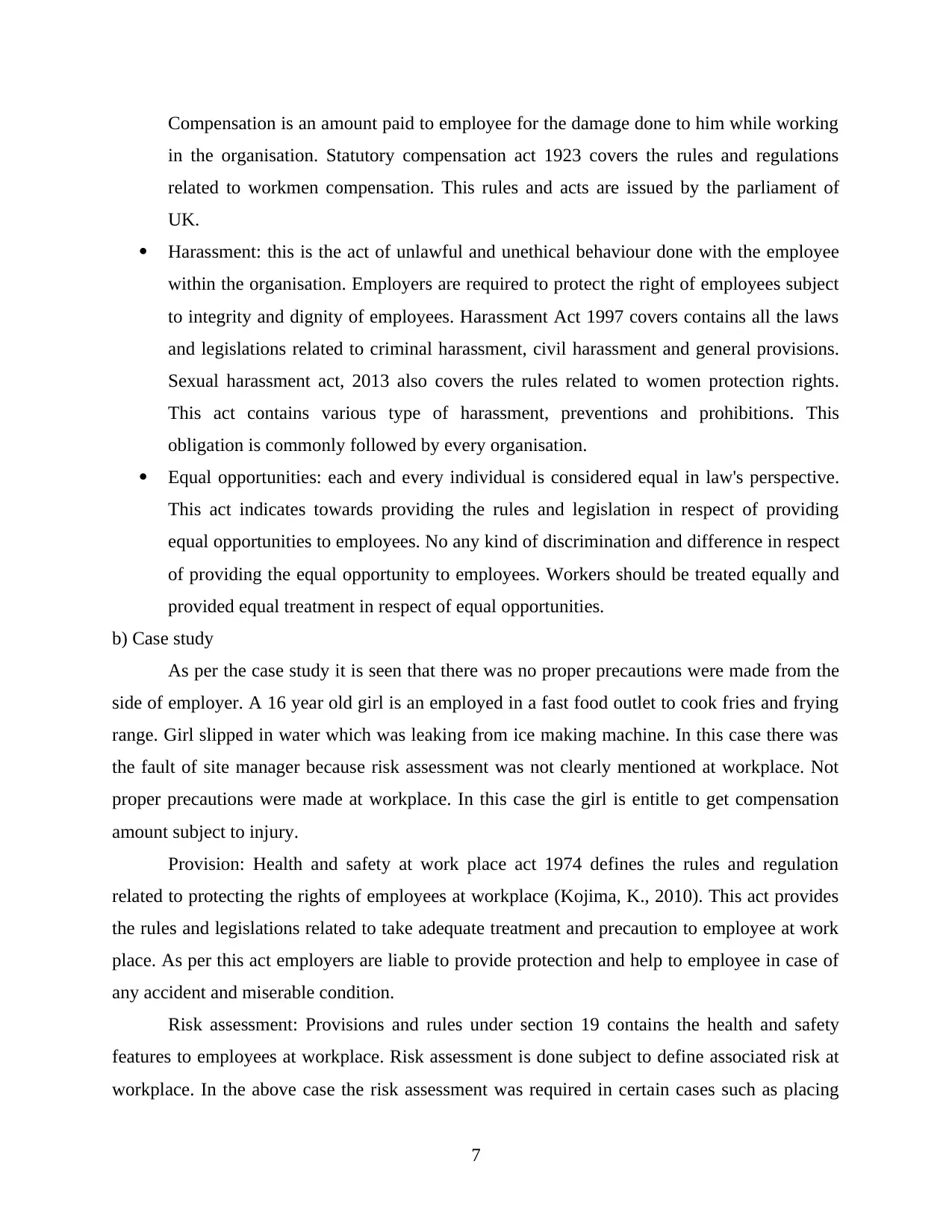
Compensation is an amount paid to employee for the damage done to him while working
in the organisation. Statutory compensation act 1923 covers the rules and regulations
related to workmen compensation. This rules and acts are issued by the parliament of
UK.
Harassment: this is the act of unlawful and unethical behaviour done with the employee
within the organisation. Employers are required to protect the right of employees subject
to integrity and dignity of employees. Harassment Act 1997 covers contains all the laws
and legislations related to criminal harassment, civil harassment and general provisions.
Sexual harassment act, 2013 also covers the rules related to women protection rights.
This act contains various type of harassment, preventions and prohibitions. This
obligation is commonly followed by every organisation.
Equal opportunities: each and every individual is considered equal in law's perspective.
This act indicates towards providing the rules and legislation in respect of providing
equal opportunities to employees. No any kind of discrimination and difference in respect
of providing the equal opportunity to employees. Workers should be treated equally and
provided equal treatment in respect of equal opportunities.
b) Case study
As per the case study it is seen that there was no proper precautions were made from the
side of employer. A 16 year old girl is an employed in a fast food outlet to cook fries and frying
range. Girl slipped in water which was leaking from ice making machine. In this case there was
the fault of site manager because risk assessment was not clearly mentioned at workplace. Not
proper precautions were made at workplace. In this case the girl is entitle to get compensation
amount subject to injury.
Provision: Health and safety at work place act 1974 defines the rules and regulation
related to protecting the rights of employees at workplace (Kojima, K., 2010). This act provides
the rules and legislations related to take adequate treatment and precaution to employee at work
place. As per this act employers are liable to provide protection and help to employee in case of
any accident and miserable condition.
Risk assessment: Provisions and rules under section 19 contains the health and safety
features to employees at workplace. Risk assessment is done subject to define associated risk at
workplace. In the above case the risk assessment was required in certain cases such as placing
7
in the organisation. Statutory compensation act 1923 covers the rules and regulations
related to workmen compensation. This rules and acts are issued by the parliament of
UK.
Harassment: this is the act of unlawful and unethical behaviour done with the employee
within the organisation. Employers are required to protect the right of employees subject
to integrity and dignity of employees. Harassment Act 1997 covers contains all the laws
and legislations related to criminal harassment, civil harassment and general provisions.
Sexual harassment act, 2013 also covers the rules related to women protection rights.
This act contains various type of harassment, preventions and prohibitions. This
obligation is commonly followed by every organisation.
Equal opportunities: each and every individual is considered equal in law's perspective.
This act indicates towards providing the rules and legislation in respect of providing
equal opportunities to employees. No any kind of discrimination and difference in respect
of providing the equal opportunity to employees. Workers should be treated equally and
provided equal treatment in respect of equal opportunities.
b) Case study
As per the case study it is seen that there was no proper precautions were made from the
side of employer. A 16 year old girl is an employed in a fast food outlet to cook fries and frying
range. Girl slipped in water which was leaking from ice making machine. In this case there was
the fault of site manager because risk assessment was not clearly mentioned at workplace. Not
proper precautions were made at workplace. In this case the girl is entitle to get compensation
amount subject to injury.
Provision: Health and safety at work place act 1974 defines the rules and regulation
related to protecting the rights of employees at workplace (Kojima, K., 2010). This act provides
the rules and legislations related to take adequate treatment and precaution to employee at work
place. As per this act employers are liable to provide protection and help to employee in case of
any accident and miserable condition.
Risk assessment: Provisions and rules under section 19 contains the health and safety
features to employees at workplace. Risk assessment is done subject to define associated risk at
workplace. In the above case the risk assessment was required in certain cases such as placing
7
⊘ This is a preview!⊘
Do you want full access?
Subscribe today to unlock all pages.

Trusted by 1+ million students worldwide
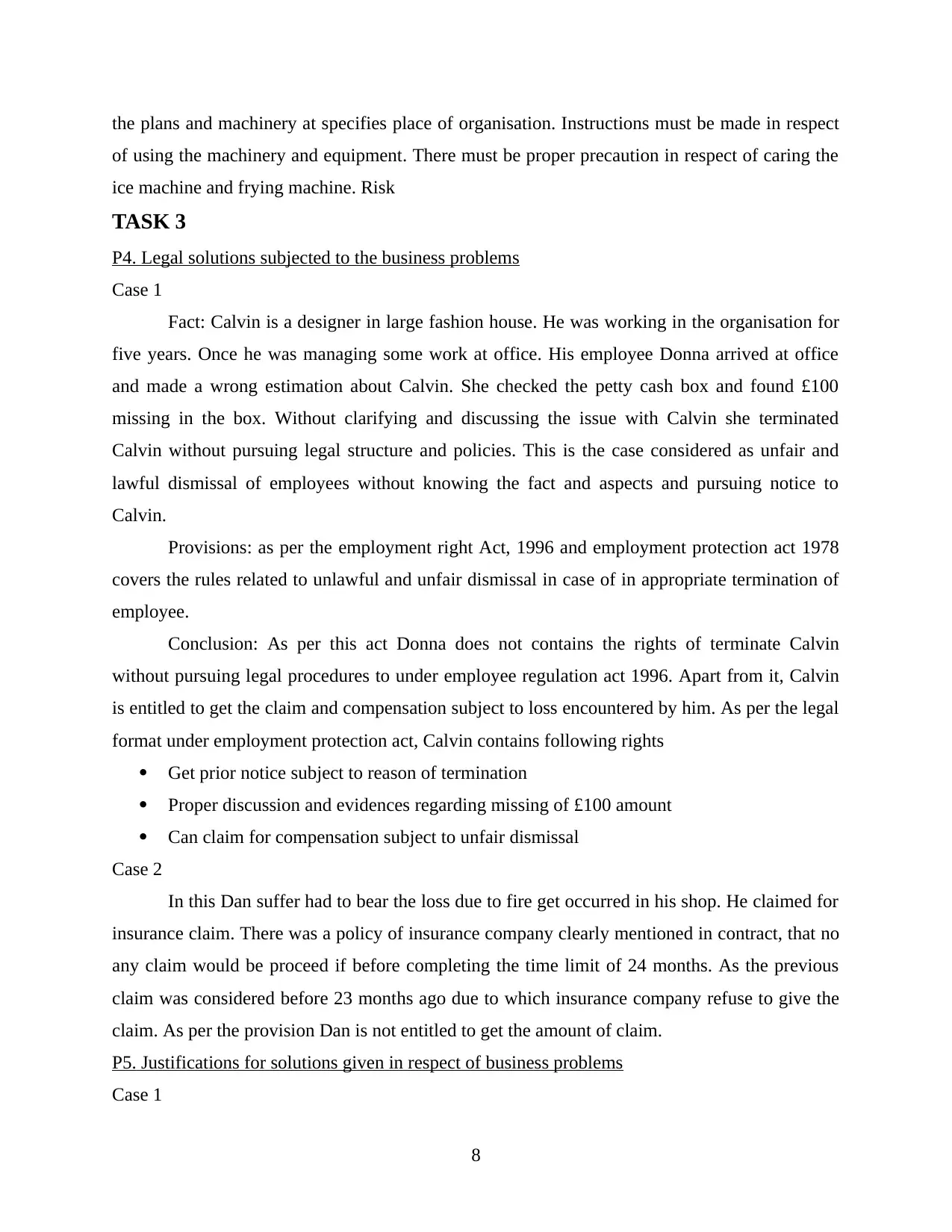
the plans and machinery at specifies place of organisation. Instructions must be made in respect
of using the machinery and equipment. There must be proper precaution in respect of caring the
ice machine and frying machine. Risk
TASK 3
P4. Legal solutions subjected to the business problems
Case 1
Fact: Calvin is a designer in large fashion house. He was working in the organisation for
five years. Once he was managing some work at office. His employee Donna arrived at office
and made a wrong estimation about Calvin. She checked the petty cash box and found £100
missing in the box. Without clarifying and discussing the issue with Calvin she terminated
Calvin without pursuing legal structure and policies. This is the case considered as unfair and
lawful dismissal of employees without knowing the fact and aspects and pursuing notice to
Calvin.
Provisions: as per the employment right Act, 1996 and employment protection act 1978
covers the rules related to unlawful and unfair dismissal in case of in appropriate termination of
employee.
Conclusion: As per this act Donna does not contains the rights of terminate Calvin
without pursuing legal procedures to under employee regulation act 1996. Apart from it, Calvin
is entitled to get the claim and compensation subject to loss encountered by him. As per the legal
format under employment protection act, Calvin contains following rights
Get prior notice subject to reason of termination
Proper discussion and evidences regarding missing of £100 amount
Can claim for compensation subject to unfair dismissal
Case 2
In this Dan suffer had to bear the loss due to fire get occurred in his shop. He claimed for
insurance claim. There was a policy of insurance company clearly mentioned in contract, that no
any claim would be proceed if before completing the time limit of 24 months. As the previous
claim was considered before 23 months ago due to which insurance company refuse to give the
claim. As per the provision Dan is not entitled to get the amount of claim.
P5. Justifications for solutions given in respect of business problems
Case 1
8
of using the machinery and equipment. There must be proper precaution in respect of caring the
ice machine and frying machine. Risk
TASK 3
P4. Legal solutions subjected to the business problems
Case 1
Fact: Calvin is a designer in large fashion house. He was working in the organisation for
five years. Once he was managing some work at office. His employee Donna arrived at office
and made a wrong estimation about Calvin. She checked the petty cash box and found £100
missing in the box. Without clarifying and discussing the issue with Calvin she terminated
Calvin without pursuing legal structure and policies. This is the case considered as unfair and
lawful dismissal of employees without knowing the fact and aspects and pursuing notice to
Calvin.
Provisions: as per the employment right Act, 1996 and employment protection act 1978
covers the rules related to unlawful and unfair dismissal in case of in appropriate termination of
employee.
Conclusion: As per this act Donna does not contains the rights of terminate Calvin
without pursuing legal procedures to under employee regulation act 1996. Apart from it, Calvin
is entitled to get the claim and compensation subject to loss encountered by him. As per the legal
format under employment protection act, Calvin contains following rights
Get prior notice subject to reason of termination
Proper discussion and evidences regarding missing of £100 amount
Can claim for compensation subject to unfair dismissal
Case 2
In this Dan suffer had to bear the loss due to fire get occurred in his shop. He claimed for
insurance claim. There was a policy of insurance company clearly mentioned in contract, that no
any claim would be proceed if before completing the time limit of 24 months. As the previous
claim was considered before 23 months ago due to which insurance company refuse to give the
claim. As per the provision Dan is not entitled to get the amount of claim.
P5. Justifications for solutions given in respect of business problems
Case 1
8
Paraphrase This Document
Need a fresh take? Get an instant paraphrase of this document with our AI Paraphraser

First case is related to the case law of Lord McLaren in Bett Vs Dalmey oil co (1905), the
court gave the decision in the favour of employee and provide an obligation in respect of
employer. As per the case law, Employers is required do risk assessment and provide safe
working condition to employee. In case of any accident company is liable to pay compensation.
Case 2
This case contains the two part, first part covers the rules and regulation related to unfair
and unlawful dismissal of employee and second part is related to misrepresentation of
information. As it is required to follow the legal procedure of following the terms and conditions
mentioned in contract. Dan would be able to claim after completing the time limit of 24 months.
TASK 4
P6. Comparison between two recommendations in respect of alternative legal solutions
a) ADR: it stands for Alternative Dispute resolution approach. This is the approach used
by the parties when they do not get satisfactory results and treatment from judiciaries and courts
(Lawrence and Weber, 2014.). It reduce the burden of traditional courts and judiciaries and
helped the parties to get the benefits. There is no any further legislation and policies are
introduced to complete the process.
According to UK law, Alternative dispute resolutions is very useful or beneficial for the
organization in resolving conflicting situations at workplace because three major methods are
falls under this approach. For example; mediation, negotiation and arbitration. These three tools
are distinct from each other in various terms which are explained as follows-
Negotiation- According to this element, parties which are engaged in conflicts are come
closer to clear all the doubts and issues. Basically, there is absence of any other party and both
members are trying to clear things by themselves.
Mediation- In this method, third party whomsoever are performing at workplace or part
of an organization are involved in this for resolving the disputes which is incurred between two
other members. It means, in this tool there is presence of third party but he/she is a part of
organization might be manager, or other line manager, supervisor etc.
Arbitration- According to this component, an organisation needs to hire professional or
any legal member and agent for clearing the doubt which is occurred between two members. In
fact, this method is totally official due to the involvement of professional person as well as takes
maximum chance in resolving conflicts.
9
court gave the decision in the favour of employee and provide an obligation in respect of
employer. As per the case law, Employers is required do risk assessment and provide safe
working condition to employee. In case of any accident company is liable to pay compensation.
Case 2
This case contains the two part, first part covers the rules and regulation related to unfair
and unlawful dismissal of employee and second part is related to misrepresentation of
information. As it is required to follow the legal procedure of following the terms and conditions
mentioned in contract. Dan would be able to claim after completing the time limit of 24 months.
TASK 4
P6. Comparison between two recommendations in respect of alternative legal solutions
a) ADR: it stands for Alternative Dispute resolution approach. This is the approach used
by the parties when they do not get satisfactory results and treatment from judiciaries and courts
(Lawrence and Weber, 2014.). It reduce the burden of traditional courts and judiciaries and
helped the parties to get the benefits. There is no any further legislation and policies are
introduced to complete the process.
According to UK law, Alternative dispute resolutions is very useful or beneficial for the
organization in resolving conflicting situations at workplace because three major methods are
falls under this approach. For example; mediation, negotiation and arbitration. These three tools
are distinct from each other in various terms which are explained as follows-
Negotiation- According to this element, parties which are engaged in conflicts are come
closer to clear all the doubts and issues. Basically, there is absence of any other party and both
members are trying to clear things by themselves.
Mediation- In this method, third party whomsoever are performing at workplace or part
of an organization are involved in this for resolving the disputes which is incurred between two
other members. It means, in this tool there is presence of third party but he/she is a part of
organization might be manager, or other line manager, supervisor etc.
Arbitration- According to this component, an organisation needs to hire professional or
any legal member and agent for clearing the doubt which is occurred between two members. In
fact, this method is totally official due to the involvement of professional person as well as takes
maximum chance in resolving conflicts.
9

b) In the case of Antwon and Tyrell Both are the employee working in relations. Dispute
arises regarding manufacturing the software and sharing the profit. They did not get any
satisfactory solution in that condition they decided to take the helps of ADR approach. Dispute
get resolved by implementing the approach in three terms such as arbitration, mediation and
negotiation. Basically, arbitration is best approach for this case because both of them are friends
are failed to identify actual mistake. It means presence of professional helps in clearing all the
hidden issues without any partiality.
CONCLUSION
Assignment is prepared to explain the meaning structure and nature of English legal
system. Impact of the law on business organisations defined in this report. Importance of
government and authorities in formulating the bills and rules defined with step by step
procedure. Statutory law and common laws are highlighted in this report. Laws and legislations
are defined subject to organisational context. Employer's obligations are also defined. Business
problems and issues are discussed subject to case studies. Legal solutions are given subject to
business problems. Alternative business problems are discussed subject to case scenario.
10
arises regarding manufacturing the software and sharing the profit. They did not get any
satisfactory solution in that condition they decided to take the helps of ADR approach. Dispute
get resolved by implementing the approach in three terms such as arbitration, mediation and
negotiation. Basically, arbitration is best approach for this case because both of them are friends
are failed to identify actual mistake. It means presence of professional helps in clearing all the
hidden issues without any partiality.
CONCLUSION
Assignment is prepared to explain the meaning structure and nature of English legal
system. Impact of the law on business organisations defined in this report. Importance of
government and authorities in formulating the bills and rules defined with step by step
procedure. Statutory law and common laws are highlighted in this report. Laws and legislations
are defined subject to organisational context. Employer's obligations are also defined. Business
problems and issues are discussed subject to case studies. Legal solutions are given subject to
business problems. Alternative business problems are discussed subject to case scenario.
10
⊘ This is a preview!⊘
Do you want full access?
Subscribe today to unlock all pages.

Trusted by 1+ million students worldwide
1 out of 13
Related Documents
Your All-in-One AI-Powered Toolkit for Academic Success.
+13062052269
info@desklib.com
Available 24*7 on WhatsApp / Email
![[object Object]](/_next/static/media/star-bottom.7253800d.svg)
Unlock your academic potential
Copyright © 2020–2025 A2Z Services. All Rights Reserved. Developed and managed by ZUCOL.





